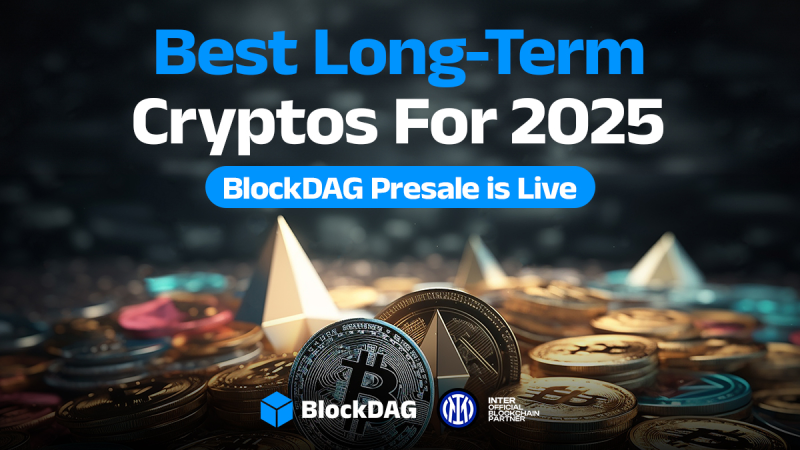 |
|
 |
|
 |
|
 |
|
 |
|
 |
|
 |
|
 |
|
 |
|
 |
|
 |
|
 |
|
 |
|
 |
|
 |
|
Cryptocurrency News Articles
The Polkadot Ecosystem: A Deep Dive into Interoperability and Scalability
Feb 02, 2025 at 12:00 am
The Polkadot ecosystem is an ambitious and highly innovative blockchain environment designed to solve one of the most significant challenges facing the broader blockchain industry today: interoperability.

The Polkadot ecosystem is an ambitious and highly innovative blockchain environment designed to solve one of the most significant challenges facing the broader blockchain industry today: interoperability. Polkadot’s ecosystem is unique in that it doesn’t just rely on a single blockchain but instead facilitates the interaction between multiple blockchains, allowing them to share data, assets, and functionality seamlessly. This has positioned Polkadot as one of the most promising blockchain networks for both developers and users who seek a flexible, scalable, and secure platform for decentralized applications (dApps), decentralized finance (DeFi), and other use cases.
The Polkadot ecosystem includes several key components, each with its own functionality and contribution to the network. These elements work together to ensure that Polkadot delivers on its promise of interoperability and scalability, laying the foundation for a fully decentralized and interconnected web.
In this article, we will explore the key aspects of the Polkadot ecosystem, the different participants involved, and how each component interacts to create a seamless and innovative blockchain environment.
1. The Core Components of the Polkadot Ecosystem
Relay Chain
At the heart of the Polkadot ecosystem is the Relay Chain, which serves as the backbone of the entire network. The Relay Chain is responsible for maintaining the overall security of the Polkadot network and coordinating communication between the different parachains (individual blockchains connected to Polkadot). It is the central hub where all transactions are processed, validated, and confirmed.
The Relay Chain performs several critical functions:
While the Relay Chain does not support smart contracts or decentralized applications (dApps) directly, its role in securing and coordinating parachains is crucial to the overall functionality of the ecosystem.
Parachains
Parachains are independent, customizable blockchains that connect to the Relay Chain. Each parachain operates as a standalone blockchain but benefits from the shared security and cross-chain communication enabled by the Relay Chain. The key innovation of Polkadot lies in the ability of parachains to interact with one another, providing a multi-chain ecosystem that allows for data and assets to flow between different blockchains in a decentralized and trustless manner.
Key characteristics of parachains:
Parathreads
Parathreads are a more flexible and cost-efficient alternative to parachains. While parachains require a dedicated slot on the network, which is auctioned for a set period, parathreads allow projects to pay-as-you-go for access to the Polkadot network.
Key characteristics of parathreads:
Bridges
One of the most exciting features of Polkadot’s ecosystem is its ability to connect with other blockchains via bridges. A bridge is a mechanism that allows Polkadot to interact with other blockchain networks, such as Bitcoin, Ethereum, or Solana.
Key characteristics of bridges:
Bridges are expected to play an important role in the future of blockchain interoperability, allowing for more complex cross-chain applications and further driving the adoption of decentralized technologies.
2. The Role of DOT in the Polkadot Ecosystem
DOT is the native cryptocurrency of the Polkadot network. It plays a central role in the ecosystem, serving multiple functions that are crucial to the network’s governance, security, and operations.
Governance
DOT holders have a say in the governance of the Polkadot network. They can propose changes, vote on upgrades, and help determine the future direction of the ecosystem. Polkadot’s governance system is designed to be decentralized and community-driven, ensuring that the network evolves in a way that aligns with the needs of its users.
Key governance features:
Staking
Polkadot uses the Nominated Proof of Stake (NPoS) consensus mechanism, and DOT plays a key role in the staking process. In this system, validators and nominators stake DOT to secure the network and validate transactions. Validators are responsible for validating blocks, while nominators select validators to support with their staked DOT.
Key staking features:
Bonding
DOT is also used for bonding new parachains to the Polkadot network. When a project wants to launch a parachain, it must lock up a certain amount of DOT tokens as a bond. This bond is returned once the parachain is no longer active on the network. The bonding process ensures that parachains are legitimate and valuable additions to the Polkadot ecosystem.
3. Key Projects and Developments in the Polkadot Ecosystem
Polkadot’s ecosystem has been rapidly growing, with numerous projects and decentralized applications (dApps) building on its platform. Here are some of the key areas and projects contributing to the expansion of the Polkadot ecosystem:
Decentralized Finance (DeFi)
DeFi is one of the most active and rapidly growing sectors in the Polkadot ecosystem. Polkadot’s interoperability and scalability features make it an ideal platform for DeFi applications that require cross-chain transactions and low transaction fees. Some notable DeFi projects in the Polkadot ecosystem include:
Acala Network (ACA): A decentralized stablecoin platform that
Disclaimer:info@kdj.com
The information provided is not trading advice. kdj.com does not assume any responsibility for any investments made based on the information provided in this article. Cryptocurrencies are highly volatile and it is highly recommended that you invest with caution after thorough research!
If you believe that the content used on this website infringes your copyright, please contact us immediately (info@kdj.com) and we will delete it promptly.
-

-

- Ethereum's Quest for Continued Dominance: Navigating Technological Evolution, Regulatory Landscape, Market Adoption, and Competition
- Feb 02, 2025 at 03:40 am
- Ethereum, since its inception in 2015, has stood as one of the most significant and influential blockchain platforms. As the second-largest cryptocurrency by market capitalization after Bitcoin, Ethereum has continually evolved, offering more than just a currency.
-

- Which Memecoin Will Make You Rich in 2025?
- Feb 02, 2025 at 03:40 am
- With 2025 just around the corner, the meme coin market is hotter than ever. As new tokens emerge and the popularity of meme coins grows, many investors are wondering which of the leading coins will prove the best investment. In this article, we'll examine four standout memecoins—Dogecoin, Floki, Shiba Inu, and Panshibi—and their potential for explosive growth in 2025.
-

-

- Dogecoin (DOGE) Set for Potential $3.5 Surge, DTX Exchange (DTX) Gaining Attention for Its KYC-Free Platform and 700% Price Surge
- Feb 02, 2025 at 03:40 am
- The cryptocurrency market continues to offer opportunities for those willing to navigate its volatile waters. While meme coins like Dogecoin (DOGE) are under increasing scrutiny, some analysts are predicting a substantial price surge for DOGE in the coming months.
-

-

- Polkadot's Decentralized Governance Model: A Deep Dive
- Feb 02, 2025 at 03:30 am
- Polkadot's governance model is one of the defining features of its ecosystem. Unlike traditional centralized systems where decision-making authority is vested in a single entity or group, Polkadot's governance is decentralized, allowing the community and token holders to participate in the evolution and management of the network.
-

-

























































